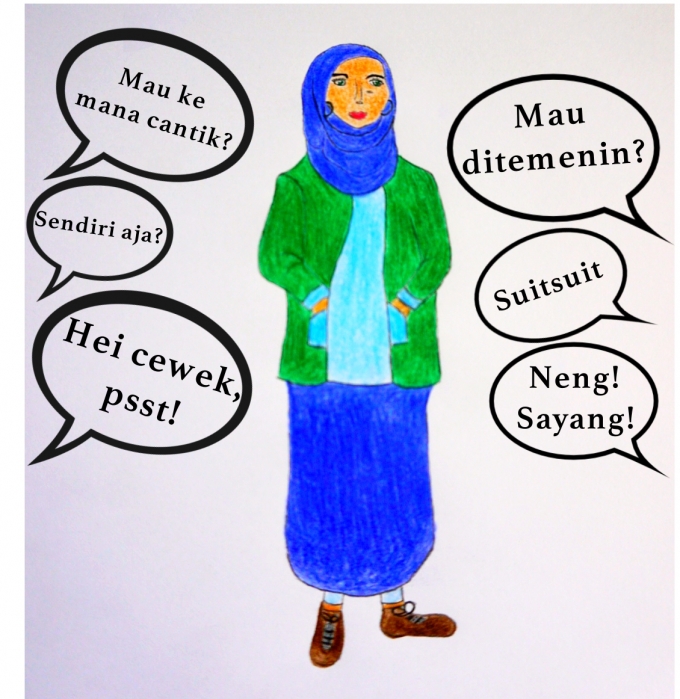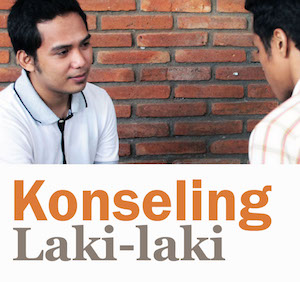Hearing a whistle when walking up the stairs next to a construction site was never a compliment for any woman. Getting called “sayang” or “neng” while going down a road does not make women feel better. Waiting for the bus and being stared at a large group of men is not going to end in her picking one of them as her husband.
Catcalling happens all over the world and is defined by the Oxford Dictionary as “A loud whistle or a comment of a sexual nature made by a man to a passing woman“. The men who are catcalling try to gain attention from women in hope for some form of (sexual) intercourse. This attempt is in less than 99,9% of the cases successful; still it doesn’t prevent men from doing so.
In reverse, most men never experience being catcalled by women. A man with a grim look on his face who walks to the train station will not be asked to smile by the women he passes by. Neither will he hear any remarks about his body or hear what the women wish to do to him without his consent. As weird and unlikely as this scenario sounds, it shows how gender-based this form of harassment is.
Raising Awareness
Women that are being catcalled, whether if its in a crowded street during the day or in a dark alleyway at night time, it is never pleasant or welcomed. It can be both scary and humiliating. Different projects have tried to raise awareness regarding this topic in the past year:
Stop Telling Women to Smile is a project by New York based artist Tatyana Fazlalizadeh. To act against "gender-based street harassment", she decided to raise awareness with public art series. Tatyana meets women that have been getting sexually unwanted comments from men and asks them whether they have something to say to those men. The words are printed in capital letters underneath the women’s portraits and posted on the street.
This is What it Feels Like is a project by Californian artist Terra Lopez. Visitors of the exhibition walk through a dimmed hallway and listen to the recorded voices of 100 women. The levels of harassment and objectification vary from “Do you have a boyfriend?” and “Can I come with you?” to the more terrifying and explicit threats, like “I’m gonna fuck you” and “I wanna rape you.” All the statements have been told like this to the women who participate in the project.
DearCatCallers is an Instagram account with 400 thousand followers run by 20-year-old Noa Jansma, a student from Amsterdam. She decided to take pictures of men that catcall her on the streets during the length of a month. This followed a discussion she had in university, when many men in her Philosophy course said they weren’t aware of the problem.[3] All the pictures have been taken with the consent of the men. From 1st of January 2018, street harassment is punishable by a fine of 190€ in the Netherlands.
Penalizing Catcallers
Argentina: In Argentina, catcallers that are proven to make sexual remarks on another person’s body, can face prosecution.[5] The same legislation also penalizes persons that conduct sexual harassment in the form of: sending images of their genitals without consent, unwanted physical contact, following someone down the street and indecent exposure can be penalized.[6] A 60$ fine or community service can be imposed to the perpetrators of these acts.[7]
France: Frances Minister for Gender Equality, Marlene Schiappa, pushed forward a legislation that criminalizes perpetrators of street harassment. This new law will allow police officers in France to arrest persons that perpetrate acts such as catcalling.[8] Currently, Marlene Schiappa is still working on the process of formulating this law.[9]
Belgium: In 2014, Belgium enacted a law that can fine persons up to 1,000 euros for committing actions such as “(…) a gesture or statement that is clearly intended to express contempt for one or more people of a different gender on the basis of their gender or to make them appear inferior or reduce them to their sexual dimension in a way that constitutes a serious attack to their dignity”.[10]
These examples show that actions are being made internationally towards ending catcalling. Both creative projects and legal actions can help to improve the situation worldwide. This shows that catcalling is considered a crime, and its perpetrators should be processed under the appropriate criminal justice system of each country.
Catcalling in Yogyakarta
In Yogyakarta street harassment is happening as well, though it is not as frequently reported as in other places like New York City. 23 year old H. from Sweden did her exchange student program at Universitas Gadjah Mada (UGM) in the past semester. One evening she went home from dinner with friends and was followed by a man who touched her bottom. 19 year old L. from Jakarta experienced catcalling frequently, especially when walking alone in the dark, passing by groups of men. This made her become increasingly more alert. 20 year old S. from Kalimantan has experienced catcalling while being alone and in groups of friends, hearing remarks like “halo mbak” and “sendirian aja mbak?”. Therefore, she became more cautious and tried not to make eye contact with people on the street anymore. As these experiences are so usual for women, many take it as a normal everyday treatment they can’t do anything against. As long as men don’t get physical they simply try to ignore it as they fear aggressive or violent behaviour as a response. 21 year old N. from Jakarta was followed by a man on a motorbike who whistled at and called her “neng” repeatedly. 18 years old F. from Germany was first asked “mau ke mana cantik?” several times and then kissed on the cheek by the men who was an ojek driver. She didn’t do anything about it as she was both shocked and paralysed.
Turning the Tables
Why is it so deep rooted in the structure of society that women feel like they can’t do anything against it and men see it as normal or even a form of complimenting women. A seemingly easy solution would be to not allow women to go out alone anymore. This happens to be a form of victim blaming and is furthermore denying women's basic rights. It is the same argumentation that blames women for becoming victims of rape. Remarks such as “you shouldn’t have been wearing this”, “you shouldn’t have been so nice”, “you shouldn’t have been out at night” is an incorrect way of thinking and detrimental to women’s basic rights. In fact it is the man who committed the crime so the change has to be brought by him as the offender. A thief who steals money out of a house will be asked by the police to return the theft, refrain from committing future crimes and has to face the consequences. Nobody would think that the people in the house “were asking for it” because they had their money stored inside or the security protection wasn’t that good.
Ending it Where it Starts
What needs to change in this “catcalling culture” is the understanding and recognition of men that what they do is wrong and that they need to tell it on to their friends, neighbours, family members and colleagues. Education needs to start early in school and trainings need to be conducted. Even though laws against catcalling will be hard to enforce, having one is a symbolic sign that a change in society is coming up. Catcalling on the streets might seem far away from actual rape, but it starts with objectifying women, using sexist jokes, emphasizing gender-based stereotypes that lead to harassment, threats and verbal abuse.[11] This is a form of psychological violence as it prevents them from feeling safe during their simple daily life routines and reinforces unequal power structures. Speaking up against “catcalling culture” in the very beginning can help to prevent further harm in the future.
“Dear catcallers, as you are harassing a woman, she is the daughter, mother, cousin, sister, wife or best friend of someone. If this happened to your loved ones, how would you feel?”
Author: Julian Martin, student at the Faculty of Law and Malin Klinski, student at the Faculty of Social and Political Sciences, both at Universitas Gadjah Mada.
Cartoon Ilustration by Malin Klinski
[1] http://stoptellingwomentosmile.com/About
[2] Hatch, Jenavieve. Moving art project puts men at the receiving end of catcalling. 02.09.2017. Huffington Post.
[3] Thiele, Sarah. Wir müssen das nicht hinnehmen. Süddeutsche Zeitung Magazin. 06.10.2017
[4] Hosie, Rachel. Meet the woman who takes selfies with street harassers. The Independent. 05.10.2017
[5]Brigida, Anna-Cat. “You Can Now Get Fined for Street Harassment in Argentina.” Broadly, 7 Dec. 2016, broadly.vice.com/en_us/article/7xz94z/you-can-now-get-fined-for-street-harassment-in-argentina.
[6] “Sexual Harassment: Cat-Callers Face Fines in Buenos Aires.” BBC News, BBC, 8 Dec. 2016, www.bbc.com/news/world-latin-america-38252462.
[7] Ibid.
[8] Bell, Melissa, and Bryony Jones. “Minister on Catcalling Law: Some Men Still Say 'It's French Culture'.” CNN, Cable News Network, 19 Oct. 2017, edition.cnn.com/2017/10/19/europe/harassment-law-france/index.html.
[9] Lowe, Josh. “France Could Ban Catcalling as It Sets out to Define and Criminalize Street Harassment.” Newsweek, 20 Sept. 2017, www.newsweek.com/street-harassment-catcalling-ban-france-668069.
[10] Bershidsky, Leonid. “Europe Is Trying to Criminalize Catcalls. It Isn't Easy.” Bloomberg.com, Bloomberg, 29 Nov. 2017, www.bloomberg.com/view/articles/2017-11-29/europe-is-trying-to-criminalize-catcalls-it-isn-t-easy.
[11] 11th principle consent, the rape culture pyramid, Versions 3 & 4 created by Ranger Cervix & Jaime Chandra, Based on Version 2 created by Kate Seewald of ActionAid / Safe Cities for Women
Original Concept by Ranger Cervix








